Fertilizers refer to chemical substances that apply to crops to boost their productivity. The composition of fertilizers involves the necessary nutrients needed by the plants. Moreover, such essential nutrients are Phosphorus, potassium, and Nitrogen. Consequently, an enhancement occurs in the soil’s water retention capacity, increasing fertility. In addition, plants need 14 essential nutrients for growth and health, along with carbon, hydrogen, and oxygen from the atmosphere and water. Fertilizer provides these nutrients.
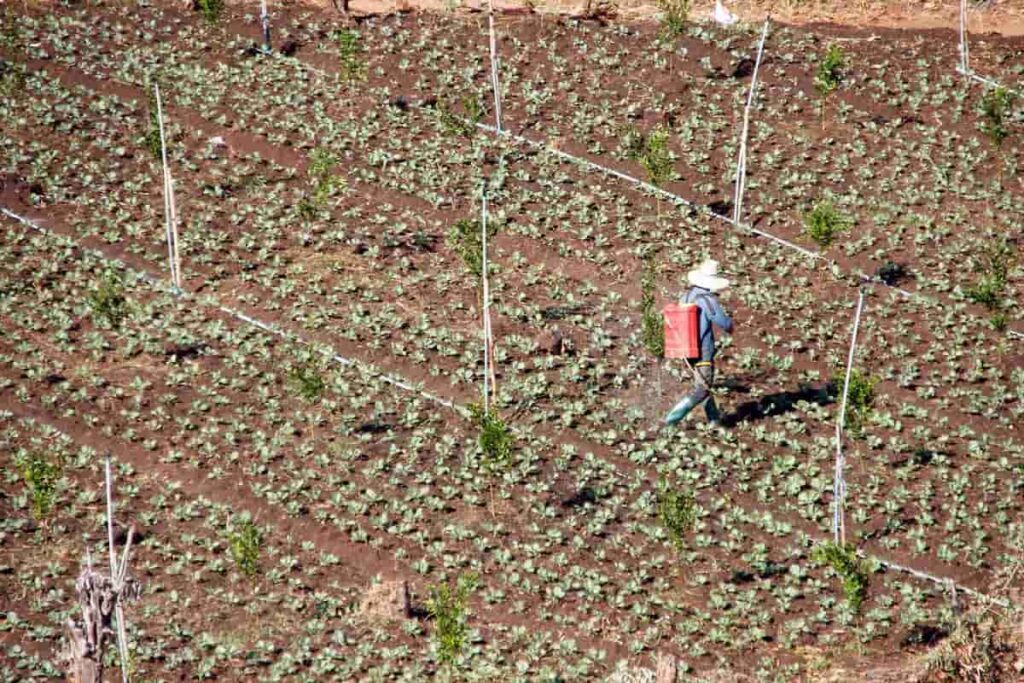
Most chemical fertilizers examples consist of 14 essential nutrients to assist plant growth. Most noteworthy, these nutrients are nickel (Ni), manganese (Mn), nitrogen (N), zinc (Zn), Phosphorus (P), molybdenum (Mo), potassium (K), chlorine (Cl), sulfur (S), magnesium (Mg), calcium (Ca), copper (Cu), iron (Fe), and boron (B).
Fertilizer schedule for vegetables
Need of fertilizer in vegetable crops
Nitrogen (N), Phosphorus (P), and potassium (K) are the most important fertilizer nutrients for vegetables. There is a much smaller requirement for other nutrients, such as iron, copper, manganese, and zinc. Apart from Nitrogen and Phosphorus, most of these nutrients are probably available in sufficient or excessive amounts in the soil. A lack of nutrients or an imbalance of nutrients can result from adding nutrients that are not required.
Important factors while deciding method of fertilizer application
When applying fertilizer, it is very important to choose the right method. The choice of method of fertilizer and its application mainly depends on the following:
- Kind of soil we are plowing
- Type of crop we are taking
- Nature of nutrient we are applying
- Irrigation facility in the area, i.e., the land is irrigated or rain-fed.
Nutrients to be used by plants must be placed in such a manner that the moisture in the soil can dissolve them. The rates and distance that plant food elements can move within the soil depend on the chemical nature of the material that furnishes the nutrients and character of the soil.
Organic fertilizers
Plants and animals are the sources of organic fertilizer. Plant & vegetable residues, animal matter & animal excreta, and mineral sources are sources of organic fertilizers. Organic fertilizers have complex biological structures, one of their main advantages. It takes time and organisms in the soil for them to break down into simpler nutrient molecules. Because this process is slow, plants consume nutrients fully and timely, unlike chemical fertilizers.
Organic fertilizers are economically better than their chemical counterparts. They can be prepared locally on the farm. Made from locally procured material, they always have better availability. They are better at environmental aspects as well. They are made from renewable ingredients, which will always be available. Organic fertilizers can be obtained from the following products:
- Agricultural waste
- Livestock manure
- Industrial waste
- Municipal sludge
In case you missed it: Top 15 Effective Organic Home Remedies for Garden Pests: Proven Control Methods
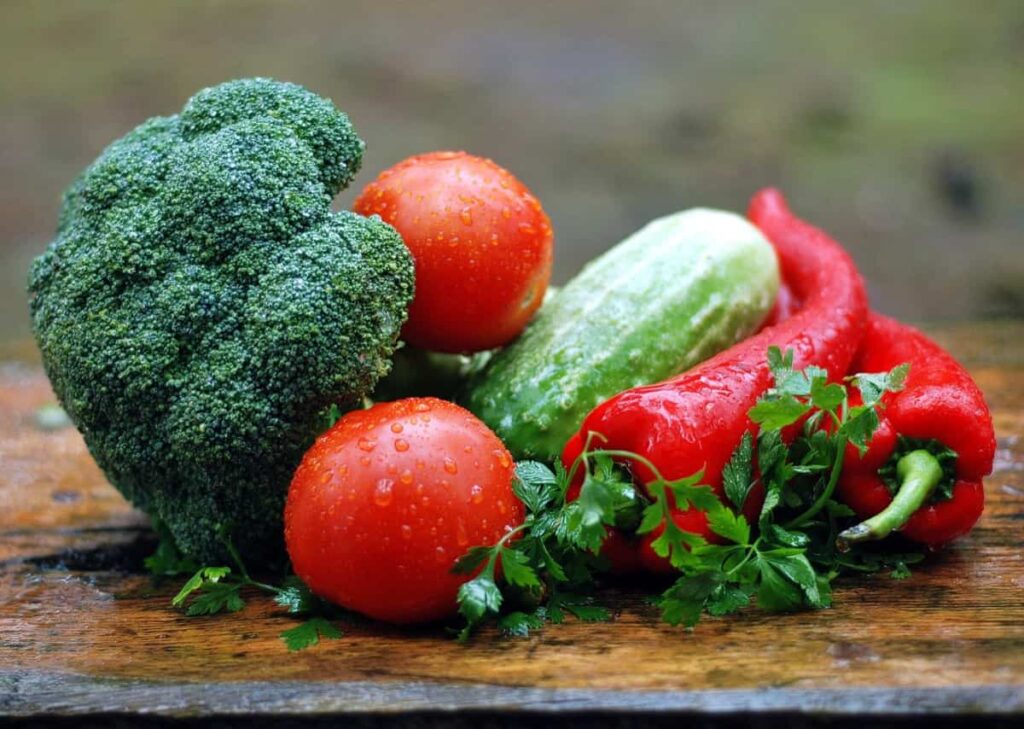
Types of organic fertilizers and their application in vegetable crops
Bloodmeal
An animal slaughterhouse produces blood meals by drying and powdering blood. Since it is such a rich source of Nitrogen, farmers must be careful not to overapply it and burn their plants’ roots. Instead, blood meal should be applied to the soil just before planting to stimulate green leaves’ growth. You can add a blood meal to your vegetable crop as a nitrogen amendment. The nitrogen level in the soil will be raised by adding blood meal, resulting in lusher and greener plants.
As soon as you see plant growth in spring, apply a blood meal. In the following months, reapply every 2 to 3 months until the growing season is over. For every 100 square feet, use between 450 and 900 grams. In the beginning, apply only 450 grams per 100 square feet until you become familiar with this product; 900 grams application is considered heavy feeding. Additionally, you can use blood meal as a side dress; again, err on the side of less rather than more since side dressing measurements are not precise.
Bonemeal
Steamed animal bones are ground into fine powder or granules for fertilizer on plants and crops. You can help your plants grow stronger and healthier by feeding them with bones full of nutrients and minerals. There is up to 15% phosphate, and it is a great source of calcium. A strong root system and flowering are also promoted by bone meal. There are, however, situations in which bone meal fertilizer isn’t appropriate.
Plants can be fertilized with a bone meal before planting or during the growing season. It is not recommended to apply organic, natural bone meal repeatedly throughout the growing season because it takes time to take effect. Before spring planting, some fertilizers containing bone meal are applied in the fall to improve the soil.
Bat guano
Whether bat fertilizer, bat manure, bat poop, or bat guano, it is all the same – bat droppings. Nutrients are conserved in caves because bat guano does not leach. There is a high amount of soluble Nitrogen, phosphorous, and trace elements in it. Any time of the year, bat guano can be used as a top dressing or diluted in tea and applied as a foliar spray.
Compost decomposes faster when activated, so it’s also a good activator. Top dressing fertilizers can be made from bat guano in wet or dried forms. Before planting or during active growth, you can incorporate it directly into the soil or water your plants with a solution referred to as “bat guano tea.”
Shell meal
The bones or shells of crabs and other shellfish are crushed to produce shellfish fertilizer. It provides a good source of calcium, Phosphorus, and trace minerals. In addition, shellfish fertilizer has one of the most important advantages: it contains chitin, which encourages the growth of organisms that inhibit harmful pest nematodes through their chitin.
Apply shellfish fertilizer several weeks before planting the garden. Broadcast 4.5 kg per 100 square feet and then rake it into the soil’s top 4 to 6 inches (10-15 cm.). It can also be worked into individual planting holes as you transplant or sow seeds. This organic fertilizer doesn’t burn plants like other fertilizers because it is slow-release. In addition, it is safe to use near water systems since the Nitrogen doesn’t leach out of the soil and into water runoff.
In case you missed it: Organic Foxtail Millet Farming: Production and Management Practices for Beginners
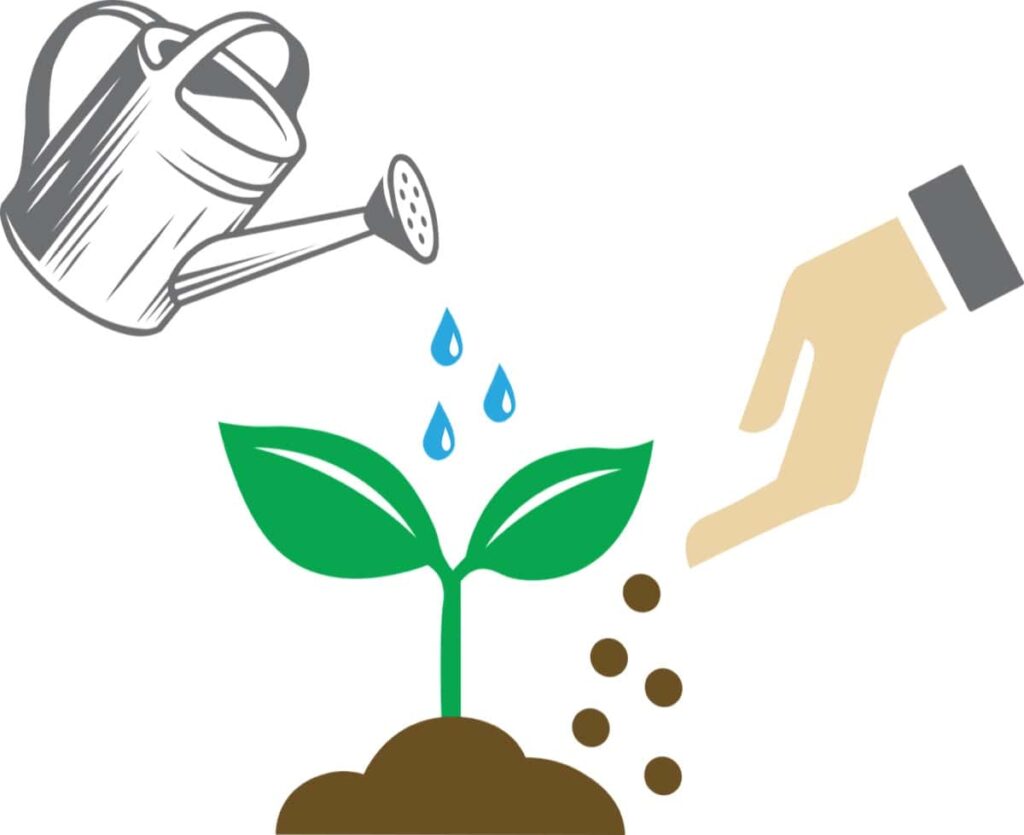
Rock phosphate
Generally, rock phosphate is a calcium or lime-based phosphate rock that usually has the consistency of small crumbs after it has been ground to a fine powder. This rock powder is estimated to contain over 30% phosphate and several trace elements. It is important to note that rock phosphate does not leach out of the soil but remains unchanged until the roots absorb it.
First, loosen the soil around the plant by raking or tilling the top layer. For Potted Plants, start with one teaspoon per container and add one tablespoon after 15 days. For ground plants or raised beds, start with one tablespoon per plant, preferably in its growing stage, and then two tables spoons after 15 days. And this one-time application will help your plant throughout its stages of growth till flowering and fruiting.
Greensand
This mineral, green sand, is composed of iron potassium silicates that give the minerals of which a green tint can be seen. The rich iron, potassium, and numerous micronutrients found in Greensand can be attributed to the fact that it is mined from an ancient New Jersey sea bed deposit of shells.
It is important to note that Greensand is not soluble in water, so it needs to be broken down in the soil. As a result, it is applied directly to the soil and is not mixed with water before being applied. Therefore, early in the spring is the time to apply it. It is important to note that the amount you will need will depend on where and how you intend to use it.
- Plants: Use 450 to 900 grams per plant, depending on size. Mix into the top six inches of soil.
- Broadcast application: Use between 25 and 45 kg for every 1,000 sq. feet of soil treated.
Animal manure
Manure is simply the waste product from animals that has been composted to remove pathogens and break them down so plants can absorb them more easily. Manures that have not been composted should be used with caution as they take longer to decompose and may contain weed seeds or diseases that can be transmitted to your landscape if not composted properly. Manure has probably been used as a fertilizer since the dawn of agriculture. Adding manure to a vegetable crop is most common in the fall. Incorporate the manure into the soil or spread it on top.
Nutritional value of animal solid and liquid excreta
| Animal | Dung (mg/g) | Urine (%) | ||||
| N | P | K | N | P | K | |
| Cow | 20-45 | 4-10 | 7-25 | 1.21 | 0.01 | 1.35 |
| Sheep and Goat | 20-45 | 4-11 | 20-29 | 1.47 | 0.05 | 1.96 |
| Pig | 20-45 | 6-12 | 15-48 | 0.38 | 0.1 | 0.99 |
| Poultry | 28-62 | 9-26 | 8-29 | – | – | – |
Vermicompost
Vermicomposting transforms kitchen scraps and other green waste into rich, dark soil that smells like earth and feels like magic. A kind of super compost made from almost pure worm castings. Besides being rich in nutrients, it also contains an abundance of microorganisms that promote soil health. The application is, therefore, best after soil tillage (if tilling is needed) and before planting. It is best to keep compost near or at the soil surface as this is where the new plants are growing, and thus the benefits of the humic acids contained in the vermicompost will be.
In case you missed it: How to Start an Organic Vegetable Farming in Telangana: Business Plan, Crops, and Subsidy
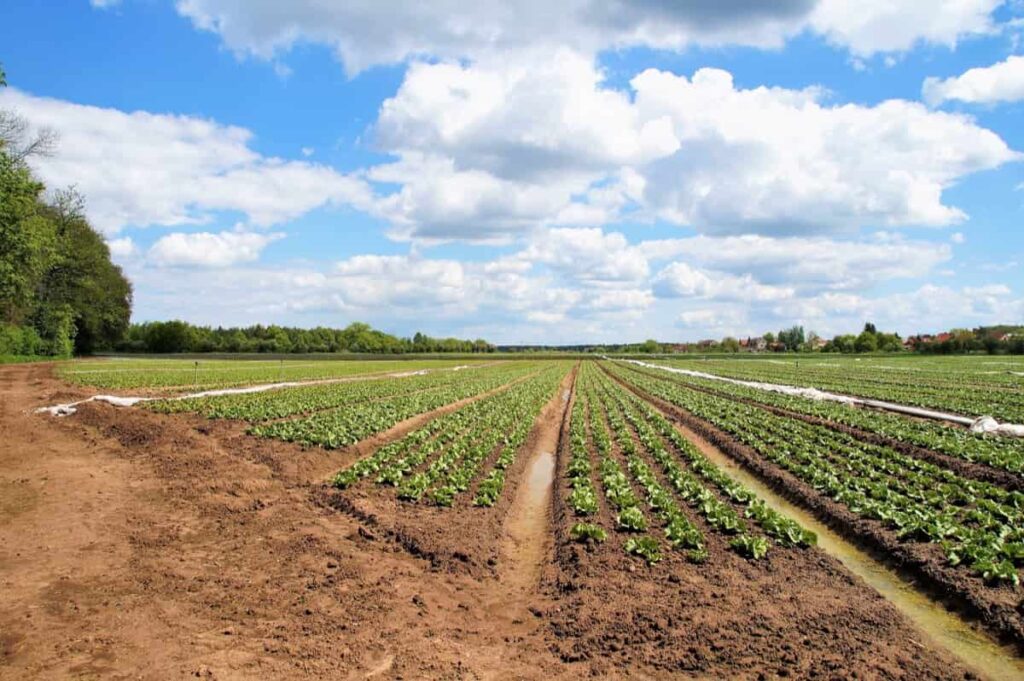
Chemical fertilizers
Understand what chemical fertilizers are made of. When buying a granular fertilizer, the bag should list the contents, including the percentage of three basic chemicals that are fundamental for plant growth. These three chemicals are represented by the label NPK on most fertilizer bags and are as follows:
Nitrogen
It is essential for leaf growth and is used in higher proportions where a large plant and lots of foliage are desirable. In addition, certain plants extract Nitrogen from the atmosphere. One example is the leguminous plants, which include peas and beans. They have nodules on their roots that absorb Nitrogen directly from the environment and require little additional chemical Nitrogen in their fertilizer. On the other hand, corn, grains, and other crops with narrow leaves often require more Nitrogen to thrive. Therefore, it is represented by the N on the standard fertilizer label.
Phosphate
It is another chemical that plants require for good health. It is a product of phosphate mines or industrial waste, and plants use the chemical Phosphorus in cellular processes. Phosphate is more common in soils containing a lot of clay and is quickly leached from sandy loams or basic sandy soils. Therefore, the Phosphate in the standard fertilizer label represents it.
Potash
It is the third chemical in the fertilizer description. It is also used by the plant at a cellular level and is necessary for good bloom production and healthy plant fruiting. It is represented by the K on the standard fertilizer label.
Secondary nutrients
Secondary nutrients are needed in lower proportions than the basic three chemicals noted above and help maintain the soil quality and contribute to healthy plants. The secondary nutrients include Calcium, Sulfur, and Magnesium.
Micro-nutrients
These are also essential for good plant health and may or may not be included in your fertilizer choice. Look for the following, in particular:
- Iron, in soluble form, helps with blooms and to keep foliage green
- Copper, in soluble form, also helps keep foliage green and will improve resistance to some diseases
- Zinc
- Manganese.
Combined organic and chemical fertilizers for vegetable crops
Pulses can be combined with vegetable farming. Pulse crops can be grown as an end crop along with vegetables or green manure. The inclusion of pulse crops leads to an encouraging increase in the yield of vegetables and stability in the yield. Moreover, growing pulse crops in the field gives them the benefit of atmospheric nitrogen fixation. 40-90 kg from pulse crops like cowpea, pea soybean, groundnut, bean, etc.
In case you missed it: Organic Vegetable Farming Plan, Advantages
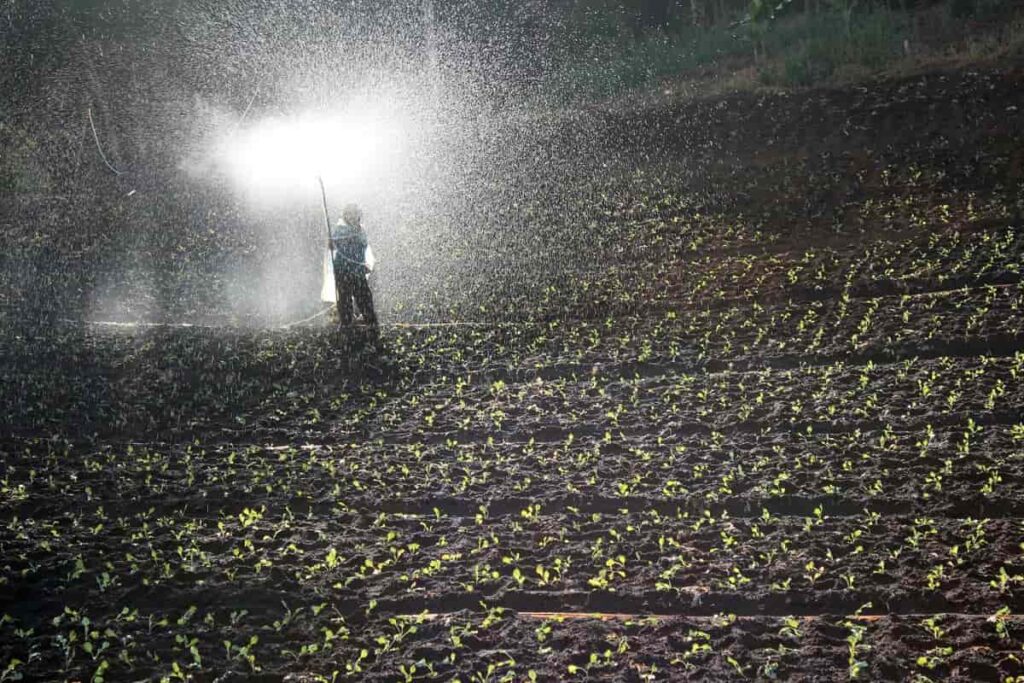
When and how to apply fertilizers in vegetable crops
- Amaranthus: Apply farm yard manure at 10 tons per acre, Azospirillum 2 kg, Phosphobacteria 800 grams per acre, N 30 kg, and K 10 kg per acre as basal doses.
- Annual Moringa: A fertilizer dose of 45:15:30 g of NPK/pit may be applied three months after sowing. Apply 45 g of N/pit after six months when the crop is bearing.
- Ash gourd: Apply 10 kg farm yard manure and 100 g of NPK 6:12:12 mixture/pit as basal and 10 g N/pit 30 days after sowing.
- Baby corn: Apply farm yard manure 5 tons per acre, NPK 30, 24, 8 kg/acre as basal, 75 kg N, and 20 kg K top dressed on the 25th day after sowing.
- Beetroot: Apply farm yard manure at 8 tons per acre and 24:64:40 kg of NPK per acre as basal and 24 kg N per acre after 30 days.
- Bellary onion: Apply farm yard manure 10 tons/acre, Azospirillum 800 g and Phosphobacteria 800 g/acre, N 20 kg, P 60 kg, and K 30 kg/acre as basal dose and N 20 kg/acre as top-dressing is done at 30 days after planting. Apply Zinc sulfate at a basal dose of 20 kg/acre at the time of the last plowing.
- Bhendi: Apply farm yard manure 10 tons per acre, N 8 kg, P 20 kg, and K 12 kg/acre as basal and 8 kg N/acre 30 days after sowing. Apply Azospirillum and Phosphobacterium each at 800 g/acre mixed in 100 kg of farm yard manure before sowing.
- Bitter gourd: Apply 10 kg of farm yard manure per pit (8 tons per acre), 100 g of NPK 6:12:12/pit as basal, and 10 g of N/pit 30 days after sowing.
- Bottle gourd: Apply 10 kg of FARM YARD MANURE (8 tins per acre), 100 g of NPK 6:12:12 mixture/pit as basal, and 10 g of N/pit 30 days after sowing.
- Brinjal: N 20 kg, P 20 kg, and K 12 kg/acre are applied as basal dose and N 20 kg/acre 30 days after transplanting. Apply 2 kg each of Azospirillum and Phosphobacteria in the main field at the planting time.
- Broad beans: Apply 10 tons per acre of farm yard manure and 20 kg P and 10 kg K/acre as basal dose. 10 kg N and 10 kg of K/acre are applied between 20 – 25 days after sowing, and another 10 kg of N is made between 40 – 45 days.
Cabbage
- Hills: Apply 12 t/acre farm yard manure, 90 kg N, 90 kg P, and 90 kg K as basal and 18:18:18 kg NPK/acre 30 to 45 days after planting.
- Plains: Apply 8 tons per acre of farm yard manure, 20 kg N, 50 kg P, and 10 kg K/acre, along with 2 kg Azospirillum as basal and 20 kg N after one month of planting and earth up.
- Capsicum: Apply farm yard manure 10 tons per acre, 16:24:12 kg NPK/acre as basal, and 16 kg N/acre on 30, 60, and 90 days of planting.
- Carrot: Twelve tons of farm yard manure per acre and 18:18:18 kg/acre NPK are applied as basal dose and 18:18:18 kg/acre NPK after 45 days of sowing. Apply 10 kg of ZnSO4/acre as basal.
Cauliflower
- Hills: Apply 12 tons per acre of farm yard manure and 8 kg N, 8 kg P, and 8 kg K as basal dose and 8:8:8 kg NPK/acre after 45 days.
- Plains: Apply 6 tons of farm yard manure/acre and 20 kg N, 40 kg P, and 20 kg K as basal and 20 kg N after 45 days. Then, apply 800 g of Departmental Vegetable micronutrient mixture without mixing with the chemical fertilizers.
- Chilli: Apply farm yard manure 10 tons per acre, N 12 kg, P 24 kg, and K 12 kg/acre as basal and 12 kg N/acre each on 30, 60, and 90 days of planting. The application of potassium in the form of potassium sulfate will increase the quality of pods.
- Curry leaf: After each harvest, 20 kg of farm yard manure/plant is applied and mixed with soil.
- Beans: Apply farm yard manure 10 tons per acre during the last plowing. 36 kg of N and 50 kg of P/acre should be applied on one side of the ridges. For rainfed conditions of Shevaroy hills, apply a basal dose of 25 kg/acre of Phosphorous as super Phosphate and another half of 25 kg/acre of Phosphorous as farm yard manure enriched super Phosphate.
- Garlic: During the last plowing, incorporate 20 tons per acre of farm yard manure; Apply Azospirillum 800 g and Phosphobacteria 800 g/acre, 16:30:30 kg/acre NPK, 20 MgSO4 and 400 kg neem cake as basal and N 14 kg/acre at 45 days after planting.
In case you missed it: Growing Grapes Organically – A Full Planting Guide
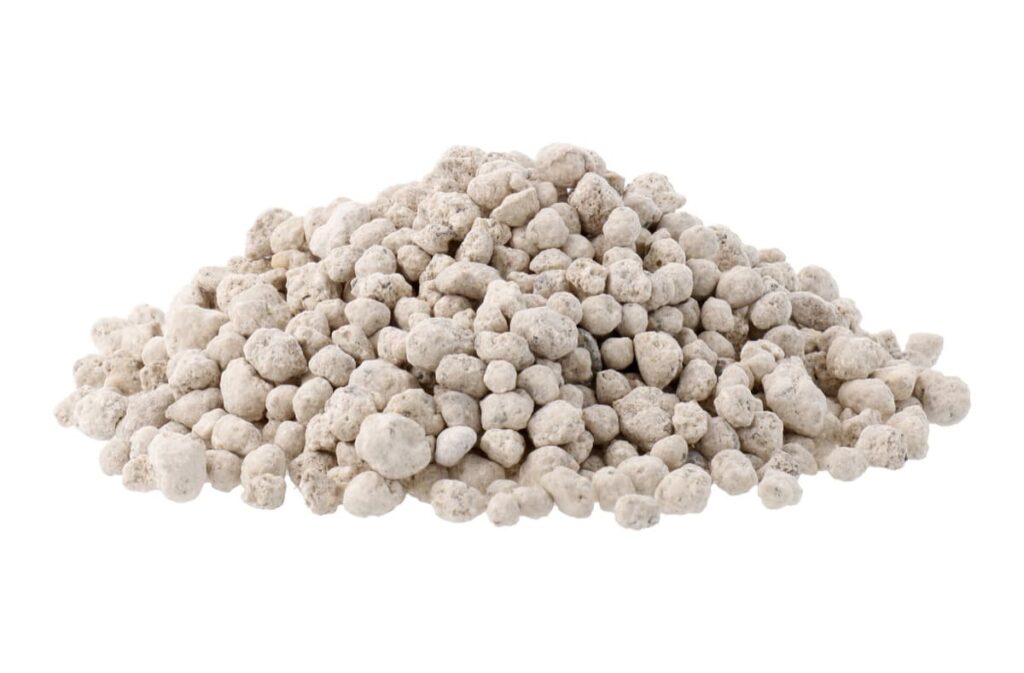
Conclusion
Vegetable crops require most of their Nitrogen after they have grown considerably or already begun to fruit. Too much Nitrogen before this time delays maturity and reduces flowering and yields. Your plants will also get Nitrogen from the breakdown of organic matter in your soil.
- Management Pests and Diseases in Your Cotton Field
- Sheep Farming Business Plan for Beginners
- Aquaponic Farming at Home: A Step-By-Step Guide
- Profitable Village Farming Business Ideas in 2024
- High-Yield Aquaculture: Fast-Growing Fish for Farming
- Effective Fish Pond Construction Techniques for Beginners
- Irrigation and Water Management in Pineapple Farming
- Blossom to Harvest: Mastering Flowering and Pollination in Papaya Farming
- Pig Fattening Essentials: From Selection to Sale for Beginners
- Raising Wagyu Cattle: A Complete Guide for Premium Beef Production
- Soil Types and Their Water Holding Capacity
- Optimizing Irrigation Schedules for Coconut Groves for Enhanced Yield
- Espresso Your Garden: Coffee Grounds for Healthier Acid-Loving Plants
- The Best Soil Mix for Snake Plants: How to Mix Your Own Snake Plant Soil
- Green Thumb Success: Expert Tips for Cultivating Greenhouse Beans All Year Round
- Bloom All Year Round: The Ultimate Guide to Indoor Hyacinth Care
- Eco-Friendly Gardening: How to Make Liquid Fertilizer from Kitchen Waste
- Ultimate Guide to Grow Anise in Pots: Explore Seed Propagation to Harvesting
- Guide to Raising Chester White Pigs: Discover Breed Facts to Growth Management
- Mastering the Elegance: The Ultimate Guide to Weeping Cherry Tree Care, Planting, and Maintenance
- Ultimate Guide to Planting Garlic in Grow Bags: Growing Strategies for Beginners
- How to Fix Spider Plant Leaf-Related Problems: Natural and Organic Remedies
- 10 Reasons Why Your Tulsi Plant is Shedding Leaves: Home Remedies and Solutions
- Optimizing Growth and Yield: The Advantages of Palm Bunch Ash Fertilizer
- Utilizing Neem Oil Extract as a Natural Pesticide for Hydrangea
- From Soil to Harvest: Various Ways in Which Farmers Can Use AI Tools
- Steps to Encourage and Induce Citrus Flowers: A Comprehensive Guide
- How to Fix Snake Plant Leaf-Related Issues: Natural and Organic Remedies
- Transform Your Garden into a Fragrant Oasis with Raat Ki Rani (Night Blooming Jasmine)
- Discover the Ideal Chicken Breeds for Philippine Farms
- How to Create a Poultry Egg Farm Business Plan for Profits
- Grow Lemon Cucumbers Like a Pro: Insider Techniques for Bountiful Yields
- Ultimate Guide to Caring for Your Pink Princess Philodendron: Tips for Thriving Variegation
- Areca Nut Profit Per Acre: Calculating Yield and Cost of Cultivation
- How Kaveri Chicken is Becoming a More Profitable Breed in Indian Backyards
- Transform Your Barn: 9 Steps to Convert a Horse Stall into a Chicken Coop
